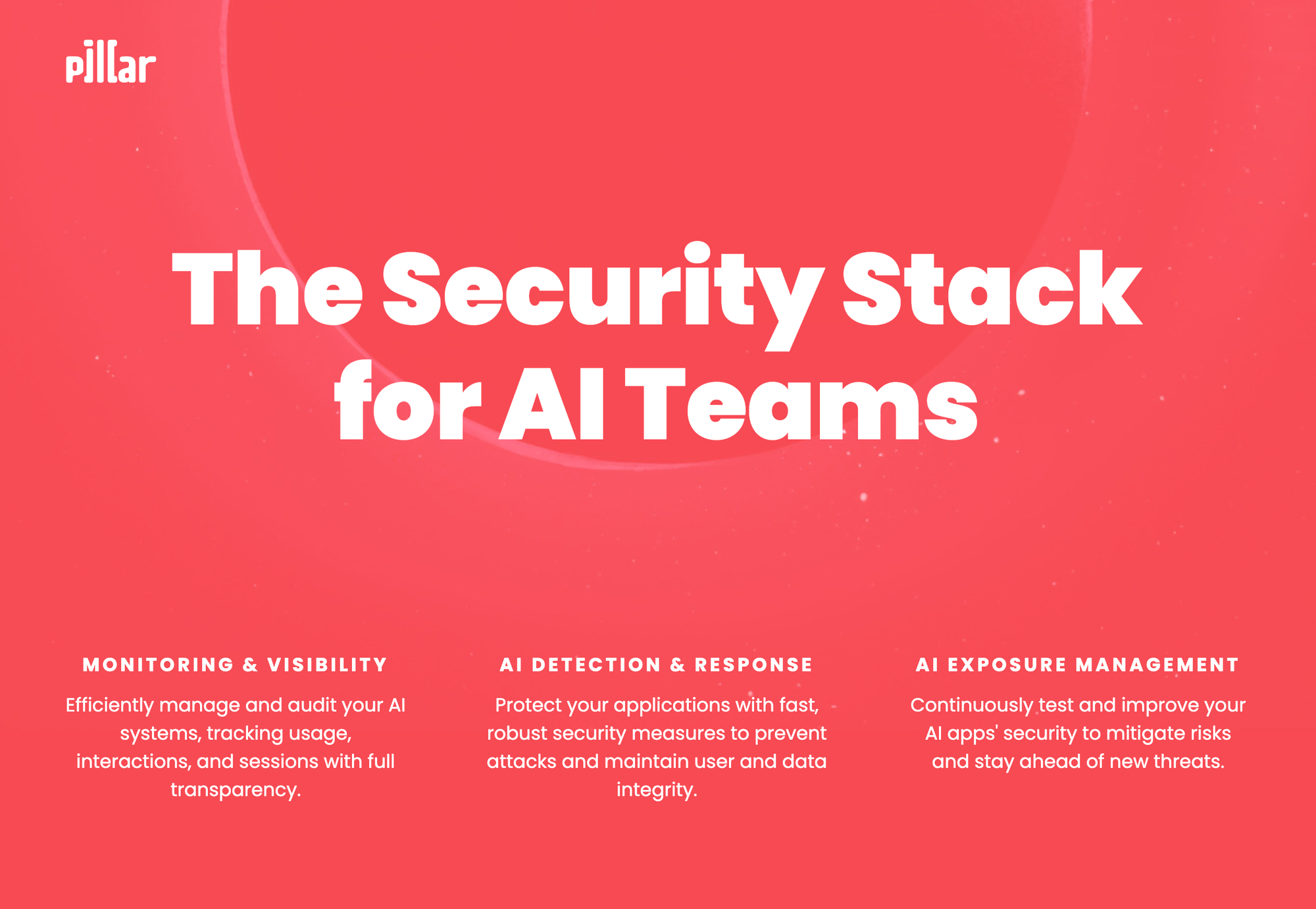Last Week in GAI Security Research - 08/19/24

Highlights from Last Week
- 🧠 Metacognitive Myopia in Large Language Models
- 🪲 Learning-based Models for Vulnerability Detection: An Extensive Study
- 📘 Natural Language Outlines for Code: Literate Programming in the LLM Era
- 📛 AttackER: Towards Enhancing Cyber-Attack Attribution with a Named Entity Recognition Dataset
- 📊 Using Retriever Augmented Large Language Models for Attack Graph Generation
- 🫣 Multimodal Large Language Models for Phishing Webpage Detection and Identification
Partner Content

Pillar Security is the security stack for AI teams. Fortify the entire AI application development lifecycle while helping Security teams regain visibility and visibility control.
- Gain complete oversight of your AI inventory. Audit usage, app interactions, inputs, outputs, meta-prompts, user sessions, models and tools with full transparency.
- Safeguard your apps with enterprise-grade low-latency security and safety guardrails. Detect and prevent attacks that can affect your users, data and AI-app integrity.
- Assess and reduce risk by continuously stress-testing your AI apps with automated security and safety evaluations. Enhance resilience against novel attacks and stay ahead of emerging threats.
🧠 Metacognitive Myopia in Large Language Models (http://arxiv.org/pdf/2408.05568v1.pdf)
- Large Language Models (LLMs) exhibit biases and stereotypes in moral judgments and evaluations due to biases in annotator selection, data approaches, and learning algorithms, highlighting the need for effective debiasing strategies.
- LLMs lack metacognitive abilities, leading to biased outcomes caused by neglect of base rates, inappropriate statistical inferences, and reliance on invalid tokens and embeddings, which are especially problematic in high-stakes decisions.
- Introducing metacognition to LLMs presents an opportunity for engineers and scientists to develop remedies for these biases, raising ethical concerns and emphasizing the importance of addressing these challenges in the implementation of LLMs.
🪲 Learning-based Models for Vulnerability Detection: An Extensive Study (http://arxiv.org/pdf/2408.07526v1.pdf)
- Sequence-based models demonstrated superior performance in detecting software vulnerabilities over graph-based models, showcasing their effective handling of source code structure.
- The inherent instability of models to minor, semantically-preserving transformations in source code highlights a substantial challenge in achieving robust vulnerability detection.
- Large Language Models (LLMs) like ChatGPT, while cost-effective, exhibited limited abilities in vulnerability detection, emphasizing the need for specialized models for this purpose.
📘 Natural Language Outlines for Code: Literate Programming in the LLM Era (http://arxiv.org/pdf/2408.04820v1.pdf)
- Large Language Models (LLMs) like Gemini and GPT-4 can generate high-quality natural language (NL) outlines for code, improving developer efficiency by aiding in code comprehension, maintenance, and navigation.
- 60% of the outlines generated by LLMs were rated as excellent by developers, and 90% were considered acceptable or better, highlighting the potential of NL outlines to enhance software development practices.
- NL outlines can accelerate the understanding and maintenance of code by providing bidirectional synchronization with code changes, thus reducing the time developers spend on program comprehension.
📛 AttackER: Towards Enhancing Cyber-Attack Attribution with a Named Entity Recognition Dataset (http://arxiv.org/pdf/2408.05149v1.pdf)
- The AttackER dataset, developed as the first cyber-attack attribution dataset tailored for Named Entity Recognition (NER), includes detailed annotations of 2640 sentences and 18 entity types to facilitate machine learning model training for automated cyber-threat analysis.
- Experiments with Large Language Models (LLMs) like GPT-3.5, Llama-2, and Mistral-7B on the AttackER dataset demonstrate a significant enhancement in NER tasks, illustrating the dataset's effectiveness in improving AI-driven cyber-attack attribution.
- Fine-tuning LLMs on the AttackER dataset led to improved performance in identifying cyber-attack entities, with GPT-3.5 showing robust F-1 scores, indicating the potential of custom-tailored datasets in enhancing NER applications within cybersecurity.
📊 Using Retriever Augmented Large Language Models for Attack Graph Generation (http://arxiv.org/pdf/2408.05855v1.pdf)
- Large language models (LLMs), specifically GPT-4, have demonstrated a sophisticated ability to automate the generation of attack graphs and threat reports by leveraging information from the Common Vulnerabilities and Exposures (CVE) database.
- The study highlighted the efficiency and accuracy of LLMs in processing unstructured textual data from threat reports and structured CVE information to generate comprehensive attack graphs, showcasing potential security vulnerabilities and attack paths.
- Automated attack graph generation via LLMs offers significant advancements in cyber threat analysis, providing nuanced understanding of vulnerabilities and attack vectors with real-time relevance, thereby enhancing the security posture with reduced manual effort.
🫣 Multimodal Large Language Models for Phishing Webpage Detection and Identification (http://arxiv.org/pdf/2408.05941v1.pdf)
- Large Language Models (LLMs) have shown significant potential in detecting phishing webpages through multimodal data analysis, achieving high detection rates and precision with the ability to provide interpretable evidence for their decisions.
- Domain verification as a second phase in phishing detection using LLMs substantially increases detection accuracy, with experiments showing a detection rate increase from 65% to 92% and precision up by 10%.
- Adversarial attacks involving perturbed logos and webpage sources were found to be less effective against LLMs due to their robustness stemming from training on massive, diverse datasets.
Other Interesting Research
- Evaluating Large Language Model based Personal Information Extraction and Countermeasures (http://arxiv.org/pdf/2408.07291v1.pdf) - Prompt injection technique notably improves defense against LLM-based personal information extraction, offering a promising avenue for enhancing digital security.
- Rag and Roll: An End-to-End Evaluation of Indirect Prompt Manipulations in LLM-based Application Frameworks (http://arxiv.org/pdf/2408.05025v2.pdf) - The Rag-n-Roll study unveils critical vulnerabilities in RAG systems, with attacks capable of misdirecting responses 40-60% of the time, urging stronger security measures.
- h4rm3l: A Dynamic Benchmark of Composable Jailbreak Attacks for LLM Safety Assessment (http://arxiv.org/pdf/2408.04811v1.pdf) - Research demonstrates h4rm3l's capability to bypass LLM safety filters with high success, revealing critical vulnerabilities and challenging existing defense mechanisms.
- Utilizing Large Language Models to Optimize the Detection and Explainability of Phishing Websites (http://arxiv.org/pdf/2408.05667v1.pdf) - PhishLang showcases the effectiveness of Large Language Models in detecting phishing websites, outperforming conventional methods with advanced explainability features for improved user engagement.
- Preserving Privacy in Large Language Models: A Survey on Current Threats and Solutions (http://arxiv.org/pdf/2408.05212v1.pdf) - Empowering privacy in LLMs through Differential Privacy and Machine Unlearning, addressing adversarial threats and regulatory compliance.
- KGV: Integrating Large Language Models with Knowledge Graphs for Cyber Threat Intelligence Credibility Assessment (http://arxiv.org/pdf/2408.08088v1.pdf) - LLMs and knowledge graphs significantly improve cyber threat intelligence assessment by facilitating claim verification and reducing manual workload.
- Transformers and Large Language Models for Efficient Intrusion Detection Systems: A Comprehensive Survey (http://arxiv.org/pdf/2408.07583v1.pdf) - Transformers and LLMs enhance IDS but face challenges like interpretability and adaptation to new threats.
- Large Language Models for Secure Code Assessment: A Multi-Language Empirical Study (http://arxiv.org/pdf/2408.06428v1.pdf) - GPT-4 excels at identifying software vulnerabilities, CODEGUARDIAN dramatically enhances detection efficiency, highlighting the evolving capability of Large Language Models in cybersecurity.
- LLM-Enhanced Static Analysis for Precise Identification of Vulnerable OSS Versions (http://arxiv.org/pdf/2408.07321v1.pdf) - Vercation leverages LLMs for semantic analysis, significantly improving the identification of vulnerable open-source software versions with high precision and recall, and reveals errors in established vulnerability databases.
- On Effects of Steering Latent Representation for Large Language Model Unlearning (http://arxiv.org/pdf/2408.06223v1.pdf) - Adaptive RMU offers a computationally efficient, targeted approach to unlearning in LLMs, enhancing safety and robustness against attacks while maintaining performance on retained tasks.
- A RAG-Based Question-Answering Solution for Cyber-Attack Investigation and Attribution (http://arxiv.org/pdf/2408.06272v1.pdf) - The RAG-based QA model surpasses traditional GPT models in cyber-attack attribution by offering more accurate, relevant, and reliable information with reduced hallucinations.
- SHIELD: LLM-Driven Schema Induction for Predictive Analytics in EV Battery Supply Chain Disruptions (http://arxiv.org/pdf/2408.05357v1.pdf) - SHIELD sets a new standard in EV battery supply chain disruption prediction by combining LLM insights with domain expertise, significantly enhancing predictive accuracy and interpretability for proactive risk management.
- ConfusedPilot: Confused Deputy Risks in RAG-based LLMs (http://arxiv.org/pdf/2408.04870v3.pdf) - Research reveals RAG systems' vulnerabilities to security breaches and proposes mitigation strategies to safeguard integrity and confidentiality.
- Nob-MIAs: Non-biased Membership Inference Attacks Assessment on Large Language Models with Ex-Post Dataset Construction (http://arxiv.org/pdf/2408.05968v1.pdf) - Reducing biases in LLM training datasets significantly decreases MIA performance, amidst rising legal concerns over copyrighted material use.
- LLM-Based Robust Product Classification in Commerce and Compliance (http://arxiv.org/pdf/2408.05874v1.pdf) - LLMs outperform traditional models in e-commerce product classification, offering resilience against data perturbations and enhancing compliance efficiency for international trade.
- ChatGPT Meets Iris Biometrics (http://arxiv.org/pdf/2408.04868v1.pdf) - ChatGPT-4's breakthrough in iris biometrics showcases its advanced adaptability, precision, and superior performance, setting a promising trajectory for future biometric security solutions.
Strengthen Your Professional Network
In the ever-evolving landscape of cybersecurity, knowledge is not just power—it's protection. If you've found value in the insights and analyses shared within this newsletter, consider this an opportunity to strengthen your network by sharing it with peers. Encourage them to subscribe for cutting-edge insights into generative AI.


